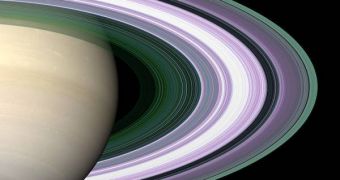Ever since the 17th century, when Italian astronomer Galileo Galilei discovered that Saturn had rings around it, astronomers and astrophysicists have been trying to come up with a plausible explanation for how they were formed and why. To this day, the answer has eluded them, and each new scientific find about the planet, made with space telescopes or with the Cassini-Huygens space probe, only goes on to further deepen the mystery.
Modern scientific means have allowed researchers to determine the fact that the multiple rings around the planet are made up of vast amounts of dust, ice and small rock fragments. Though they are only a few tens of feet in thickness, they are extremely widespread, and contain some 35 trillion-trillion tons of material inside them. They also possess the remarkable ability of regenerating themselves, if, for example, a space rock passes through. After the initial shock, the material mysteriously pulls itself together again, Space reports.
Thanks to readings collected by Cassini and its Voyaged predecessors, it has now become obvious that the rings are in a process of constant evolution. Ring arcs have been photographed as forming in some instances, while one of the planet's many moons has been identified as emitting plumes of ice and dust, which contribute to the formation of new rings. But exactly how the rings appeared in the first place is still a matter of mystery.
Some believe that the rings could have appeared from materials that were found originally in the protoplanetary disk, but which could not clump together and form moons because of the planet's immense gravitational and tidal pull. Others believe that the remains may have originated from a previous Saturn moon, destroyed by a massive impact with a comet or asteroid. Eerie patterns can also be distinguished within the rings, which resemble spokes on a wheel. They may have been formed by moonlets dipping through the rings, in wobbly orbit around the planet.
But some new Cassini data offer evidence that the rings may have formed gradually, and not all at once. For instance, it has been recently proven that Enceladus spews ice and dust with so much fury, that it practically feeds Saturn's E Ring, causing it to grow. Other moonlets orbit the planet inside rings of dust made from their own debris, emitted as microasteroids bombard their surfaces. In any case, the debate on how all of the rings formed is most likely to endure for some time, as consensus is still far away.

 14 DAY TRIAL //
14 DAY TRIAL //